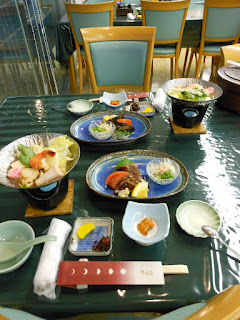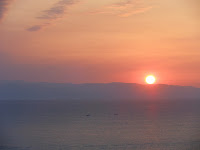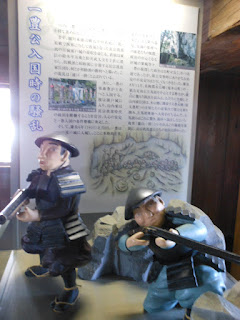After leaving the castle we had a snack instead of a full lunch because it was already after 2 and we knew we were having a big dinner.
 |
Okonomiyaki with cheese on a stick!
Okonomiyaki is a savory pancake - usually served flat.
|

Then off to the hotel which was a city, or government run place. Very well run. It was right on the beach and we had an incredible view from our window.
 |
| 'Welcome' in Kochiben (Kochi dialect) - 'You've arrived well' |
 |
| Map of Kochi |
 |
| Not a swimming beach, strong undertow. |

Views from our window.
Yukata are provided for after the bath and for sleeping - but you can wear them to dinner if you like.
We took a walk on the beach before the sun went down because the difference in temperature between sunny spots and shady was significant.


 |
| On the way back, and actually all over we passed this flag. Ryouma Holiday - a play on the movie 'Roman Holiday'. Sakamoto Ryouma is a very famous historical figure who wanted to 'open' Japan but was assassinated when he was 33. He'll be happy to know that his face is now on souvenier cookies and crackers. |

 |
| This is his museum. |
 |
| Some more historical figures. (On the side of a bus.) |

 |
A Tosa dog (the type of breed).
|

The hotel has a beautiful 'onsen' (really just a public bath - not mineral water) with a view over the beach and ocean (if you are taller than me when sitting down in the pool of water.) But kneeing I could see out. There was a bridal couple having their pictures taken at the water's edge. Dinner and breakfast came with the room (Y 10710, about $100 each), and you could 'upgrade' to a bigger (better) meal if so desired. Luckily we didn't!!! Here's what we had - the 'standard'.
 |
pickles on the left, squid coated in uni
(sea urchin) on the right. |
 |
| The dining room. |
 |
| Nabe (hot pot) |
 |
| Kumiko in her Yukata |
 |
| fish with grated radish |
 |
The famous katsuo, slightly grilled on the outside, raw inside.
Served with sliced raw garlic, onions, scallions, shiso and tomato. |
 |
Tempura - I ate the piece of white fish before I remembered
to take the picture... surprise hot pepper on the right. |
 |
| Yummy Tosa sake. |
 |
| clear soup |
And an orange for dessert.
Sufficiently full, and sleepy, we returned to the room. But it was cold since we hadn't turned on the heater so we went back to the onsen to warm up. Before bed we watched a very cute British drama called 'extra' on Kumiko's computer. It's made for teaching/learning English. Then early to bed - around 9:30 (when I usually get home). Not the best night's sleep for me, woke up every hour or so and I finally got up around 5:30 since the sea lions (at the little 'aquarium' or sea park) were barking and there was some mechanical noise, etc. At around 6:40 I was rewarded with a beautiful sunrise over the mountains and ocean. Back for a morning dip in the onsen and then onto breakfast.
 |
| Pickled cucumber and umeboshi. |
 |
| Something from tofu. |
 |
Chiriman, very popular and evidently the babies of the
fish on the left. |
 |
| Small dried fish (aya ?) - you grill to soften. |
 |
| Fish cake and barley (?) from making barley miso |
 |
| Salad and miso soup. |
And there was rice, tea, and coffee. There had been a choice upon check in of a Japanese breakfast or western. The western looked really good actually, but I don't usually have Japanese breakfasts so I went with that.
After buying a few omiyage (gifts to take home), we packed up and headed east to the cave. Unbelievable as it may seem to my boys, Kumiko's sense of direction is even worse than mine! Would have been a fairly 'dangerous' situation if not for good old 'navi' (GPS). The cave was less than an hour away and almost deserted. I think maybe there were a handful of people the whole time we were there. But then we saw a bus going up that way so hopefully the cave is where they were headed.
As readers of my previous blogs will know - I LOVE caves. But this one, for some reason left me underwhelmed. It's quite long - the path is about 1 km., many very tight squeezes - sideways (wouldn't work in the US with bigger people) and many places where even I had to duck down quite a bit. All that is good in my book, but I don't know, maybe it was the concrete and metal flooring and stairs in most of it, and the lack of stalagtites and mites in the first half. The second half was much better and the only difference I can think of was the presence of stalagmites and tites... It was interesting but I wasn't left with the sense of awe I usually feel in caves. But it was fun and warmer inside than out, and on the way back to the car we had a little yuzu sherbert.
We found the highway thanks to 'navi', stopped once for some noodles at a rest stop and went through loads of tunnels. I think I must have dozed off on the bus on the way to Kochi because I really didn't remember there being so many tunnels. The drive took about 3 hours.
It was a very nice weekend and really felt like a little vacation.




 Views from our window.
Views from our window.





































































































































